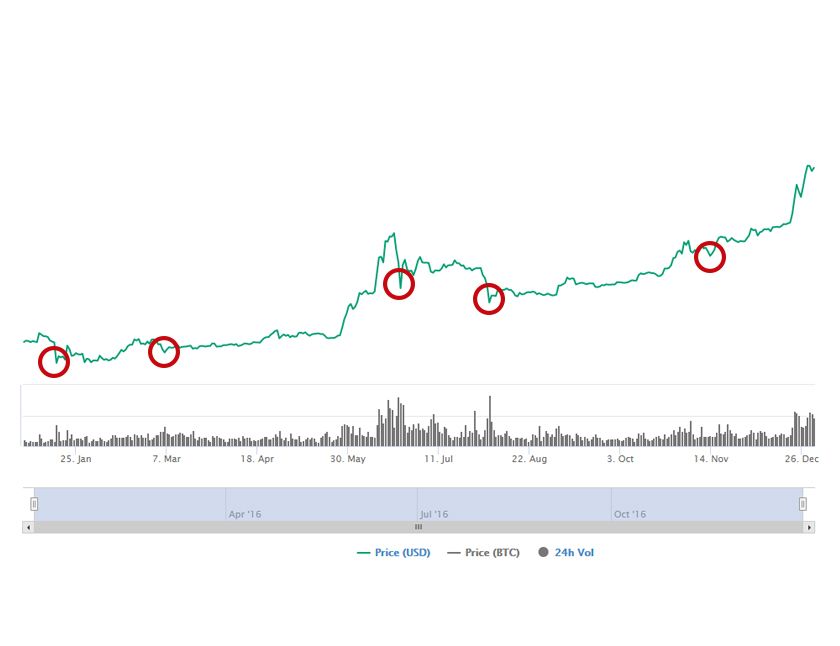Crypto Guide For Non-Technical People: Trading Basics
The first time I rode a rollercoaster (a real one, not the ladybug kiddyride) it was a breathtaking experience, in every sense of the word. My breath stocked, the higher we climbed and I was preparing for a drop beyond imagination. After that, arriving safely in the station, I was breathless, speechless and my legs felt like pudding.
Cryptocurrency-trading can feel like that. But with a few exceptions. Where in a rollercoaster the drop probably is the best part, in crypto the ride up is much more fun. My first few months in trading crypto were a steep learning-curve. The climb was fun. Little bumps along the way but nothing fancy. The everyday look at my portfolio was breathtaking, and I thought I made the best decision in my life.
Lesson 1: Always expect a drop
Whenever you entered the cryptotrading world, you either have experienced or will experience a steep drop in price. The current state the cryptomarket is in, it will happen at least every quarter of a year. So be prepared. I know I wasn't when I experienced the first big dip.
I just discovered that most people advised to hodl. Buying some coins and don't do anything with them for at least a year. Let them ride the waves. While the wave was upward, that wasn't much of a problem. The value of my portfolio rose every day. So when the bleeding started, I thought it was a little bump. People screaming the market would correct at least 30% downwards, I thought, were mad. It happened before, they said. Why would history repeat itself? Well, because it does. At least in crypto.

Just take a graph from a random coin (Bitcoin for example), from a whole year. Last year, the year before, doesn't matter. Look at it. Even if you don't understand technical analysis, you probably understand that a line up is increase of value, and a line down decrease. After a spike in price there always is a correction. I highlighted a few bigger ones, but there are a lot more. Which brings me to lesson 2.
Lesson 2: Never buy at all-time high
With all-time high (ATH) I mean the highest value a coin has ever reached. Let's take Bitcoin again for example. On November 17, 2017, Bitcoin was worth about $8,000. On December 17th, Bitcoin reached a new high of $20.000. The rise seemed unstoppable. But another month later, Bitcoin was only worth $10.000. Everyone who bought Bitcoin after the 29th of November and didn't sell was at loss in January.
Because the market is in a downtrend at the moment, new all-time high's are rare. But the theory applies even when a coin reaches its highest price in the period of one month. Corrections happen. So, if you researched a coin, and like to buy it, but you see a fast rise in value, don't get in but be patient. Wait for the correction. It can save you a lot of money, or gives you the opportunity to buy more coins for the same amount.
Lesson 3: Respect the Bitcoin
Bitcoin or BTC is the best known cryptocurrency out there. You probably heard of it years before you started to trade. When you say you trade crypto, most common people will react with something like ,,Ah, so you have Bitcoins?'' Because of that, there are a lot of opinions on the Bitcoin as well. Most of them very positive, or very, very negative. Bitcoin is somewhat the Guinness of crypto. You either love it or hate it, not much inbetween.
When I started trading, I disliked Bitcoin somewhat. Maybe because it was the first, maybe because of the valuation, maybe because of the worshippers in cryptospace, or a combination of those. I decided my portfolio could do without it. It would be stupid to buy a coin of a few thousand dollars, while there were coins of a few cents out there, I told myself. And at the same time I could shut up the people who asked if I had plural Bitcoins. Mistake again.
When the market rose, Ethereum (the 2nd largest coin by market cap) did exceptionally well. And because a lot of exchanges also offered ETH pairings to trade, I decided to go with Ether. At the time, transaction fees of Bitcoin were really high, the network was overloaded which made transactions slower, and several people believed Ethereum would take over the first spot from Bitcoin in just a matter of time.
Unfortunately, with the dip in the cryptomarket, every coin went down, but despite the fact that Bitcoin lost almost 75% of it's highest value, most of the altcoins (alternatives for BTC) dropped even harder. To make matters worse, when the market was recovering, Bitcoin recovered a lot faster than all the other alts, including Ethereum. So, to put things simple: Despite the fact that the whole cryptomarket is volatile as f###, it's a good thing to hold Bitcoin, at least for 25%-40% of your total portfolio value. It lowers the risk of complete loss of value of your coins. And it gives some sort of stability, although I know that also is relative.
Lesson 4: Don't hold only small coins
If you are as stubborn as me, you probably won't buy Bitcoin, even after reading the above advice. No problem. I for one, trade in Bitcoin as well now, but I normally hold Ethereum. More risk, maybe more gains in the long run. This applies for small (low valued) coins as well. The risk/reward ratio is higher with smaller assets.
But, (and this is something you absolutely have to do,) make sure to hold at least 25% of your portfolio in one of the big coins, with trading pairs on exchanges. The big coins at the moment are BTC and ETH, and maybe in a lesser way NEO. This could change over time, but for now these are the ones you should look for.
When the market corrects downward, the altcoins, especially the small ones, will bleed the most. This is because traders move their money out of those coins into bigger coins, like Bitcoin, or pull out (sell) completely. That's why Bitcoin recovers faster as well. So, small coins only spike in value when Bitcoin is stable. If you hold a lot of low valued coins, you probably have to wait much longer for the value of your portfolio to recover after a dip.
Lesson 5: Look at the Coin Marketcap
Small coins with low value seem very attractive at first sight. We all know the story of Bitcoin, worth almost nothing a few years ago, and now worth thousands of dollars. All starting investors who don't put money in crypto for the tech hope to find the new Bitcoin. A coin worth less than a cent, so you can pick up a few thousand, and hope to be rich in no-time. While you could hit the jackpot, the chance is bigger that you won't. And you can actually know beforehand.
Just take a look at https://coinmarketcap.com/. Find a cheap coin, and look at the circulating supply. That is the total amount of coins available at the moment. Now look at Bitcoin. There are 16.9 million Bitcoin at the moment. When all BTC is mined, there will be 21 million Bitcoin, no more.
If each coin is worth $10.000, and you think a coin like Tron will hit that, I can tell you, that's almost impossible. Just because of the circulating supply, which is 65 billion for Tron. That's 3000x the amount of Bitcoin. So, even when Tron would become as big as Bitcoin worth 10k, their coin would approximately be worth $3,20.
So, if the pennycoin you eyed as the new Bitcoin has a much higher total supply than Bitcoin, I can guarantee you it won't hit $10.000. Of course, even Tron could hit 10k, but that would mean the whole market would blow up massively and Bitcoin would be worth 30 million dollar per coin. So it's highly unlikely. In a future blog, I will cover more details of looking at a coin marketcap and how to interpret it. For now my tip is, just look at the number of coins available.
There's a lot more to dive into, but this already is a quite extensive read, so I leave more of the basics for a new post. Let trading crypto be as much fun as a rollercoaster. Don't put money in you cannot miss. Only than you can sit back and enjoy the rollercoaster-ride of a lifetime without puddinglegs.
Give me a heads up if you liked it, and if you have questions, or suggestions for future coverage, please leave a comment.
Disclaimer
I don't provide financial advice and I am not a professional trader. Be aware of the risks trading crypto.
If I write about certain technologies/coins it's my main purpose to explain, not to promote them. these blogs are not sponsored or part of bounty programs.
This blog is not financial advice, but for informational purposes only. Trading crypto is at your own risk.
All imagery used can be found un-edited on https://pixabay.com (free stock pictures) or are made by myself.
